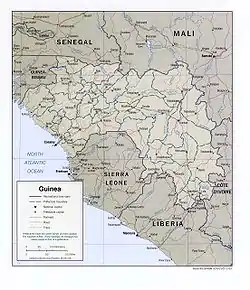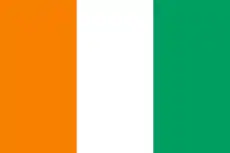Outline of Guinea
The following outline is provided as an overview of and topical guide to Guinea:


Guinea – country located in West Africa, that was formerly known as French Guinea.[1] Guinea's territory has a curved shape, with its base at the Atlantic Ocean, inland to the east, and turning south. The base borders Guinea-Bissau and Senegal to the north, and Mali to the north and north-east; the inland part borders Côte d'Ivoire to the south-east, Liberia to the south, and Sierra Leone to the west of the southern tip. Its water sources include the Niger, Senegal, and Gambia rivers. Guinea is sometimes called Guinea-Conakry (Conakry being its capital) to differentiate it from the neighboring Guinea-Bissau (whose capital is Bissau).
General reference

- Pronunciation: /ˈɡɪni/
- Common English country names: Guinea or Guinea-Conakry
- Official English country name: The Republic of Guinea
- Common endonym(s):
- Official endonym(s):
- Adjectival(s): Guinean
- Demonym(s):
- ISO country codes: GN, GIN, 324
- ISO region codes: See ISO 3166-2:GN
- Internet country code top-level domain: .gn
Geography of Guinea

- Guinea is: a country
- Population of Guinea: 9,370,000 - 87th most populous country
- Area of Guinea: 245,857 km2
- Atlas of Guinea
Location
- Guinea is situated within the following regions:
- Time zone: Coordinated Universal Time UTC+00
- Extreme points of Guinea
- High: Mont Nimba 1,752 m (5,748 ft)
- Low: North Atlantic Ocean 0 m
- Land boundaries: 3,399 km
 Mali 858 km
Mali 858 km Sierra Leone 652 km
Sierra Leone 652 km Cote d'Ivoire 610 km
Cote d'Ivoire 610 km Liberia 563 km
Liberia 563 km Guinea-Bissau 386 km
Guinea-Bissau 386 km Senegal 330 km
Senegal 330 km
- Coastline: North Atlantic Ocean 320 km
Environment of Guinea

- Climate of Guinea
- Geology of Guinea
- Protected areas of Guinea
- Wildlife of Guinea
- Fauna of Guinea
- Birds of Guinea
- Insects of Guinea
- Mammals of Guinea
- Fauna of Guinea
Natural geographic features of Guinea
- Glaciers in Guinea: none [2]
- Forests in Guinea
- Guinean mangroves
- Rivers of Guinea
- World Heritage Sites in Guinea
Regions of Guinea
Ecoregions of Guinea
Ecoregions in Guinea – the following ecoregions lie partially within Guinea:
Administrative divisions of Guinea
Regions of Guinea
Prefectures of Guinea
Municipalities of Guinea
- Capital of Guinea: Conakry
- Cities of Guinea
Demography of Guinea
Government and politics of Guinea
- Form of government: presidential republic
- Capital of Guinea: Conakry
- Elections in Guinea
- Political parties in Guinea
Branches of the government of Guinea
Government of Guinea
Executive branch of the government of Guinea
- Head of state: President of Guinea
- Head of government: President of Guinea
- Cabinet of Guinea
- Cabinet of the First Republic of Guinea – governing body of Guinea from independence on 28 September 1958 until the death of President Ahmed Sékou Touré on 26 March 1984, followed by a bloodless coup by Colonel Lansana Conté on 5 April 1984.
- Ministers of Justice of Guinea
Legislative branch of the government of Guinea
Judicial branch of the government of Guinea
Foreign relations of Guinea
- Diplomatic missions in Guinea
- Diplomatic missions of Guinea
International organization membership
The Republic of Guinea is a member of:[1]
Law and order in Guinea
Law of Guinea
Military of Guinea
- Command
- Forces
Local government in Guinea
Local government in Guinea
History of Guinea
History of Guinea, by period
- Early history – see history of West Africa
- Sahelian kingdoms – the area which is now Guinea lay on the fringes of these Kingdoms
- Imamate of Futa Jallon – West African theocratic state based in the Futa Jallon highlands of modern Guinea. The state was founded around 1727 by a Fulani jihad and became part of the French colonial empire in 1896.
- Wassoulou Empire – short-lived (1878–1898) empire of West Africa built from the conquests of Dyula ruler Samori Touré and destroyed by the French colonial army.
- Anglo-French Convention of 1882 – confirmed the territorial boundaries between Guinea and Sierra Leone around Conakry and Freetown.
- Rivières du Sud – administrative division of colonial French West Africa
- French Guinea – colony until 1958, part of French West Africa
- Independence – in 1958, the colony chose independence from France, and named itself Guinea
- Ahmed Sékou Touré – ruled as president from 1958 to 1984
- Cabinet of the First Republic of Guinea – governing body of Guinea from independence on 28 September 1958 until the death of President Ahmed Sékou Touré on 26 March 1984, followed by a bloodless coup by Colonel Lansana Conté on 5 April 1984.
- Lansana Conté – took over in a bloodless coup, and ruled as president from 1984 to 2008
- 2007 Guinean general strike
- 2008 Guinean coup d'état – Moussa Dadis Camara seized control from 23 December 2008 to 3 December 2009
- National Assembly of Guinea dissolved
- 2008 Guinean military unrest
- 2009 Guinea mine collapse
- Alpha Condé – elected president in 2010, survived an attempted coup less than a year later
- Guinean legislative election, 2013 – National Assembly of Guinea re-established
- 2014 in Guinea
History of Guinea, by region
History of Guinea, by subject
Culture of Guinea
- Architecture of Guinea
- Cuisine of Guinea
- Languages of Guinea
- Music of Guinea
- National symbols of Guinea
- People of Guinea
- Public holidays in Guinea
- Religion in Guinea
- Christianity in Guinea
- Hinduism in Guinea
- Islam in Guinea
- Scouting and Guiding in Guinea
- World Heritage Sites in Guinea
Art in Guinea
- Cinema of Guinea
- Literature of Guinea
- Music of Guinea
Sports in Guinea
Sports in Guinea
Economy and infrastructure of Guinea
- Economic rank, by nominal GDP (2007): 138th (one hundred and thirty eighth)
- Agriculture in Guinea
- Banking in Guinea
- Banks in Guinea
- Central Bank of the Republic of Guinea – located in Conakry
- Banks in Guinea
- Communications in Guinea
- Companies of Guinea
- Supermarket chains in Guinea
- Currency of Guinea: Franc
- ISO 4217: GNF
- Energy in Guinea
- Health care in Guinea
- Mining in Guinea
- Trade unions in Guinea
- Transport in Guinea
Education in Guinea
See also
| French language edition of Wikipedia, the free encyclopedia |
- Index of Guinea-related articles
- List of Guinea-related topics
- List of international rankings
- Member state of the United Nations
- Outline of Africa
- Outline of geography
References
- "Guinea". The World Factbook. United States Central Intelligence Agency. July 3, 2009. Retrieved July 23, 2009.
- The only glaciers in Africa are on Mt Kenya (in Kenya), on Kilimanjaro (in Tanzania), and in the Ruwenzori Mountains (which are located in Uganda and the Democratic Republic of the Congo). See Proceedings of the Riederalp Workshop, September 1978; Actes de l'Atelier de Riederalp, septembre 1978): IAHS-AISH Publ. no. 126, 1980.

